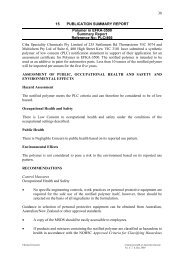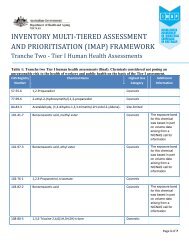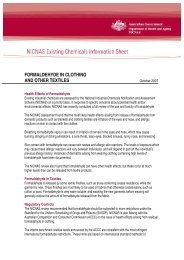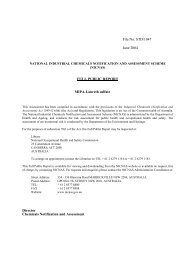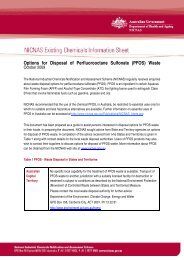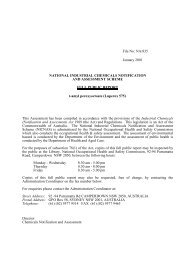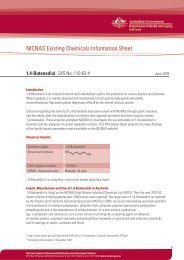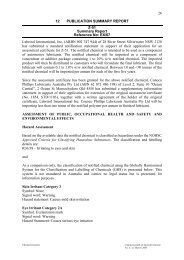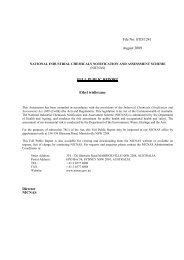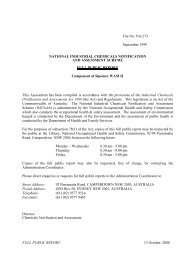GULFTENE C16-18 ISOMERISED OLEFINS - NICNAS
GULFTENE C16-18 ISOMERISED OLEFINS - NICNAS
GULFTENE C16-18 ISOMERISED OLEFINS - NICNAS
You also want an ePaper? Increase the reach of your titles
YUMPU automatically turns print PDFs into web optimized ePapers that Google loves.
compound released with drill cuttings is likely to be adsorbed onto the surface of particles of<br />
drilling waste rather than being dispersed in the water column as in the laboratory tests.<br />
In respect of the general question of biodegradation in marine environments, a preliminary<br />
report (ECETOC 1993) has concluded that if a chemical exhibits ready biodegradation under<br />
aerobic conditions in a freshwater environment, the available evidence indicates that it will<br />
also be degraded in the marine environment. The mechanisms for degradation may be either<br />
aerobic or anaerobic, but marine degradation rates are likely to be substantially reduced in<br />
comparison because of the low bacterial population in the marine environment. Low<br />
temperatures at the benthic interface would also decrease the rate of degradation.<br />
8.2.1.c Anaerobic Conditions - Freshwater Studies<br />
Test Substance: <strong>C16</strong>/C<strong>18</strong> isomerised olefin<br />
This study (Environment & Resource Technology Ltd 1996) was conducted according to the<br />
protocol ISO/TC147/SC5/WG4 which may be similar to the ECETOC screening test<br />
(ECETOC 1988) whereby the test substance is incubated at 35°C over an extended period<br />
with sewerage digester sludge maintained under anaerobic conditions. The volume of<br />
evolved CO2 and methane is measured periodically throughout the test period. The results<br />
indicated that after 56 days incubation under the test conditions, only 10.6% of the original<br />
carbon in the test substance had been metabolised to CO2 and methane. Consequently, it was<br />
concluded that the material is only slowly degraded under anaerobic conditions.<br />
The notifier also provided a second summary report (Mather JI Latham M Tapp JF 1995) on<br />
anaerobic biodegradation performed on another sample of the same material by a different<br />
laboratory. The protocols used in this test were those of ISO/CD11734, and indicated 58%<br />
degradation after 56 days incubation with sewage sludge and around 62% degradation after<br />
77 days 2 . These results are significantly better than those of the first test, but since summaries<br />
only were provided for both studies, with no details of the test methods used, no further<br />
comment can be made. However, both tests indicated slow biodegradation, and as the tested<br />
material contained close congeners of the components of Gulftene 16-<strong>18</strong>, these components<br />
are likely to behave in a similar manner.<br />
In addition to the summary reports described above the notifier provided a copy of a paper<br />
(Steber 1995) dealing specifically with the anaerobic degradation of drilling fluids<br />
components, two of which were alpha olefins. These tests were conducted using the<br />
ECETOC screening procedure with C14 alpha olefin (test duration 98 days) and with <strong>C16</strong>-<strong>18</strong><br />
alpha olefin (test duration 84 days), and the two compounds were degraded by 48.3 % and<br />
22.4% respectively. Steber (1995) was of the opinion that these results indicate moderate<br />
potential for anaerobic biodegradation.<br />
Some supplementary summary data on the anaerobic biodegradation of a synthetic drilling<br />
mud (known as “Syn-Teq Mud”) containing C14-20 isomerised alpha olefins (present at<br />
between 3 30-50%) was also supplied by the notifiers (Croudace CP Tapp JF 1995). This test<br />
2 It should be noted that the Western Australian Department of Minerals and Energy requires that this test be<br />
performed on all drilling fluids which are to be used in drilling operations off the WA coast, Cobby (1999).<br />
3 The reference indicated that the drilling mud used in the test contained 35% carbon.<br />
FULL PUBLIC REPORT 26 April 2000<br />
NA/713 Page 14 of 100



